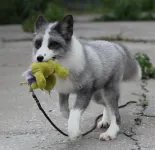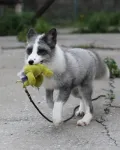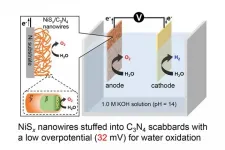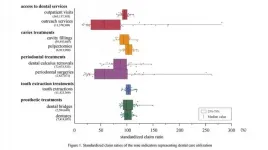Breeding foxes for opposite behaviors produces similar brain changes
Tame and aggressive foxes display increased size in similar brain regions, contrary to theory
2021-06-14
(Press-News.org) Farmed foxes selectively bred for tameness and aggressiveness exhibit similar changes to their brain anatomy, according to research recently published in JNeurosci. Both lineages also have larger brains than conventional farm-bred foxes, complicating leading theories on domestication.
Domesticated species provide insight into complex evolutionary processes on a condensed timeframe. When a species splits from its wild counterpart, its brain, body, and behavior undergo rapid changes. Studies with chickens, sheep, cats, dogs, and more indicate domestication shrinks the brain. But the same pattern does not extend to foxes in the expected way.
Hecht et al. used MRI to measure the brain size and structure of foxes from the classic Russian fox-farm experiment. The research team compared foxes selectively bred for tameness or aggression toward humans with conventional farm-bred wild foxes (the control). Contrary to previous studies, both tame and aggressive strains had larger brains than the conventional, "wild" foxes. The tame and aggressive foxes also displayed similar changes to regions in the prefrontal cortex, despite being bred for opposite behaviors. These results illuminate a need to rethink how brain circuits relate to behavior evolution as well as how domestication shapes the brain.
INFORMATION:
Paper title: Neuromorphological Changes Following Selection for Tameness and Aggression in the Russian Fox-Farm Experiment
About JNeurosci
JNeurosci, the Society for Neuroscience's first journal, was launched in 1981 as a means to communicate the findings of the highest quality neuroscience research to the growing field. Today, the journal remains committed to publishing cutting-edge neuroscience that will have an immediate and lasting scientific impact, while responding to authors' changing publishing needs, representing breadth of the field and diversity in authorship.
About The Society for Neuroscience
The Society for Neuroscience is the world's largest organization of scientists and physicians devoted to understanding the brain and nervous system. The nonprofit organization, founded in 1969, now has nearly 37,000 members in more than 90 countries and over 130 chapters worldwide.
[Attachments] See images for this press release:

ELSE PRESS RELEASES FROM THIS DATE:
2021-06-14
When Erin Hecht was earning her Ph.D. in neuroscience more than a decade ago, she watched a nature special on the Russian farm-fox experiment, one of the best-known studies on animal domestication.
The study, running since 1958, tries to replicate the natural domestication of wolves to dogs by selectively breeding two strains of silver foxes so they exhibit certain behaviors. Scientists breed one to be tame and display dog-like behaviors with people, such as licking and tail wagging. The other is bred to react with defensive aggression when faced with human contact, while a third strain acts as the control and isn't bred for any specific behaviors.
Hecht, who's now an assistant professor in the Harvard Department of Human ...
2021-06-14
Niigata, Japan - In the recent past, there has been a paradigm shift towards renewable sources of energy in order to address the concerns pertaining to environmental degradation and dwindling fossil fuels. A variety of alternative green energy sources such as solar, wind, hydrothermal, tidal etc., have been gaining attention to reduce the global carbon footprints. One of the key challenges with these energy generation technologies is that they are intermittent and are not continuously available.
"We cannot use solar energy at night and wind energy when the wind is not blowing. But we can store the generated electricity in some other forms and utilize it whenever required. That is how water splitting bridges the gap and has emerged as a very promising energy storage ...
2021-06-14
Tsukuba, Japan - Inequitable access to health care is a pressing global health concern, and care of our teeth is no exception. In fact, the World Health Organization established the Global Goals for Oral Health 2020 in its efforts to help counter socioeconomic-related imbalances. Economically advanced Japan has plentiful dentists, as well as a universal health insurance system, yet it also has oral care-related inequities, according to a new study.
A team of researchers centered at University of Tsukuba in Japan examined a huge set of claims and checkup data in search of regional and socioeconomic trends. Their findings included the key observation that regional lower ...
2021-06-14
The potential of a class of materials called perovskites to enable solar cells to better absorb sunlight for energy production is widely known. However, this potential has yet to be fully realised, particularly under real-world operating conditions.
New research published today in the prestigious journal Nature Energy, has revealed defects in a popular perovskite light absorber that impede solar cell performance. The researchers found a change in the nature and density of these 'intragrain planar defects' correlated with a change in solar cell performance.
The discovery by an international team of researchers, led by Monash ...
2021-06-14
Cities and nations around the globe are shooting for carbon neutrality, with some experts already talking about the need to ultimately reach carbon negativity. Carbon footprint declarations are used in construction to ease product selection for low carbon building, but these standards don't yet exist for green elements like soil, bushes and plants. A new study led by Aalto University is the first to map out how green infrastructure can be a resource for cities on the path to carbon neutrality.
The study, done in collaboration with the Natural Resources Institute Finland (Luke) and the University of Helsinki, charted out the lifecycle phases of plants, soils and mulches to determine the basic considerations needed to create standards for products commonly used in green ...
2021-06-14
The National Pharmaceutical Regulatory Agency (NPRA) of Malaysia has granted a conditional registration for a safe, effective hepatitis C treatment developed by a public-private partnership bringing together the Malaysian Ministry of Health, not-for-profit research and development organization Drugs for Neglected Diseases initiative (DNDi), Egyptian pharmaceutical company Pharco, Malaysian pharmaceutical company Pharmaniaga Berhad, and non-governmental-organization Médecins Sans Frontières/Doctors Without Borders (MSF).
This is the very first drug for hepatitis C virus (HCV) to be developed through South-South collaboration and with funding and clinical support from non-profit organizations.
This partnership ...
2021-06-14
A current challenge for sustainable aquaculture is how to increase the quantities of farmed fish while also reducing waste products that can lead to the accumulation of harmful fish sludge. New research aims to understand how this fish waste can be treated for use in aquaponics systems, by removing excessive carbon, yet preserving the mineral nutrients required by plants to grow.
In this study in Frontiers in Plant Science, researchers from the Department of Marine Sciences at the University of Gothenburg, Sweden, demonstrate a novel and effective way to convert this fish sludge into plant fertilizer and therefore improving the nutrients available for plants in hydroponic ...
2021-06-14
DNA is an abundant and nutritious food source for microbes
The diet of microbes is vast: They are able to use different molecules as nutrients, including biomolecules such as proteins and lipids of dead and decaying organisms. This includes so called extracellular DNA molecules which are not or no longer present in intact cells. "From the bacteria's perspective DNA is particularly nutritious," says Kenneth Wasmund, a microbiologist at the Centre for Microbiology and Environmental Systems Science (CMESS) at the University of Vienna and lead author of the study. "It's essentially a fertilizer. After all, it is a chain of millions of pieces of sugar and phosphorus- and nitrogen-containing bases." Extracellular ...
2021-06-14
Universal school lunch programs make students healthier, and increase their lifetime income by 3%, according to a unique study from Lund University in Sweden published in The Review of Economic Studies.
Health disparities arise early in life and play a major role in economic outcomes among adults. Yet there are few studies on the long-term effects of school-based nutrition policies aimed at counteracting them. Researchers from Lund University and Stockholm University can now show that universal school lunch programs have significant long-term benefits for students' education, general health and income.
"Today, we take school lunches for granted in Sweden. But the fact is, it was a very conscious ...
2021-06-14
Announcing a new article publication for BIO Integration journal. In this article the authors Yuhao Chen, Yue Li, Meng Du, Jinsui Yu, Fei Gao, Zhen Yuan and Zhiyi Chen from The Third Affiliated Hospital of Guangzhou Medical University, Guangzhou, China, University of South China, Hunan, China and University of Macau, China discuss ultrasound neuromodulation: integrating medicine and engineering for neurological disease treatment.
Neurological diseases associated with dysfunctions of neural circuits, including Alzheimer's disease (AD), depression and epilepsy, have become increasingly prevalent. To tackle these issues, artificial stimulation or regulation ...
LAST 30 PRESS RELEASES:
[Press-News.org] Breeding foxes for opposite behaviors produces similar brain changes
Tame and aggressive foxes display increased size in similar brain regions, contrary to theory



